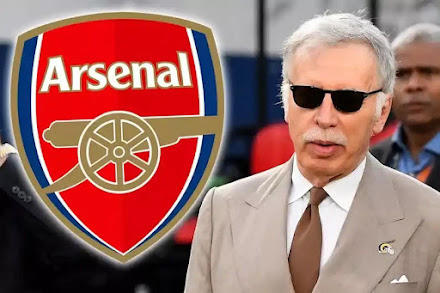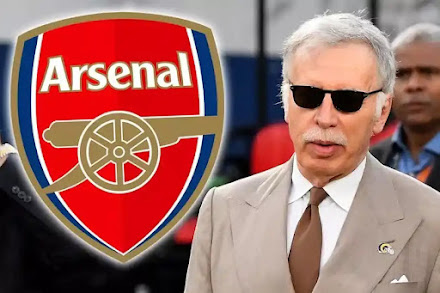Arsenal have spent big in recent years, with their outlay reflected in their major change in fortunes on the pitch under Mikel Arteta.

They have run Pep Guardiola’s all-conquering Man City side close for the Premier League title in the last two season, while 2023-24 saw them return to the Champions League for the first time in seven years.
The cash invested over that period represents something of a departure from the norm for owner Stan Kroenke, who has historically championed a more sustainable model.
Owner Stan Kroenke of the Los Angeles Rams waves to fans in the tunnel prior to an NFL football game against the Tampa Bay Buccaneers at Raymond Ja…
Photo by Kevin Sabitus/Getty Images
The 76-year-old has handed over responsibility for the day-to-day running of the club to son Josh, who has been explicit about his aim to make Arsenal a titan of European football once more.
But in an era when spending is anchored to revenue in terms of Profit and Sustainability Rules (FFP in old money), what capacity do the Gunners have to pull off the biggest signings?
To explore that question and the wider financial landscape at the Emirates, TBR spoke exclusively to Liverpool University football finance lecturer and Price of Football author Kieran Maguire.
What is Kroenke’s spending strategy at Arsenal and how does it compare to their Big Six rivals?
The blockbuster signings of Declan Rice and Kai Havertz last summer were a statement of intent for Arsenal.
Those deals, which were part of a spree that cost £200m, went a long way towards deflecting criticism of the club’s financial approach in recent years, which some fans suggested lacked ambition.
However, after crunching the numbers, Maguire believes that those insinuations were perhaps slightly unjustified.
Sometimes you have to prime the pump to move from position A to position B in terms of success on the pitch,” he said.
“Kroenke has made that decision to increase spending. They realise that they made a number of acquisitions – Aubameyang and Ozil etc – that didn’t work out or had messy and expensive endings. So I think there has been a cultural change.
“What I think has been intriguing is that Arsenal have effectively had no increase in wages since 2018.
“It was £223m in 2018 and £235m in 2023. That 2023 figure is including the bonuses that kicked in for qualifying for the Champions League for the first time in a few years.
“Kroenke junior, who is more hands-on at the club than Silent Stan, wants Arsenal to be serious players at the top table.
“That has been reflected in significant spending. But the numbers from the accounts show that there has only been one year of the last seven when they have spent less than £100m. That was in 2019, when they spend £99m.
“So I think some of the accusations that have been levelled at the owners have perhaps been a bit harsh.
“There has been significant net spend in most years, although it has taken a step up in 2022 and 2023, with net spends of £144m and £230m, so there has been an expansion.
“Squad cost was £744m at the last count, which is behind Chelsea, Man United, Man City and Liverpool but not by a huge margin. It is, however substantially ahead of Spurs.“
But, like all clubs, they are continuously looking for ways to improve their position in order to facilitate more investment in player recruitment and retention.
As well as the account-boosting quasi-swap deals that have already accounted for £245m of trading in the Premier League this summer, one avenue many clubs are increasingly exploring is academy sales.
In PSR, profit on sales is offset against a player’s value in the company accounts, which in turn is based on their initial transfer fee and how long is remaining on their contract.
However, given that academy players have no transfer fee, their sales are registered as ‘pure profit’ in terms of PSR.
Maguire explained the nuances of the PSR system and why selling even just two of the London Colney graduates would – in theory – free up £300m in potential transfer funds this summer.
“Fans are forgiving if results are good, so this only becomes an issue of identity when results suffer.
“I think this can be in the interests of all three parties. These three players are good but not guaranteed to be first picks at the Emirates, so they have the chance to play football elsewhere.
“If you sell two of them for £30m, that’s £60m profit because it is calculated as sale proceeds minus the book value of the registration, which is zero because they came from the academy.
“That is ignoring wages, of course, which obviously you have to account for if you have, say, five coming in and two going out.”
Arsenal’s commercial income – and transfer budget – has suffered from Champions League absence
Arsenal generated £173m in commercial income in 2022-23, which was a record for the club and £40m more than they achieved the previous season.
However, their income from sponsorship and merchandise is still the lowest of any of the clubs in the so-called ‘Big Six’. And by quite a margin.
Chelsea are the closest team with around £210m, with Tottenham earning £228m, Liverpool £272m, Man United £303m and Man City an eye-watering £341m.
Clubs’ spending is directly linked to how much they earn, so Arsenal’s relatively modest commercial income compared to their rivals is a concern, claims Maguire.
“I think Arsenal have treaded water for too long,” he said.
“I do think there is a correlation with the lack of exposure by virtue of not being in the Champions League for so long and being able to sign off on more lucrative commercial deals.
“We saw an increase from £147m to £173m on the back of qualifying for the Champions League. I expect to see further growth in 2024 and 2025.
“But their commercial income is about 50 per cent of Man City and £100m less than Liverpool. If you’re starting a race and you’re £100m behind a rival in terms of ability to spend, you have to be really smart to bridge that gap.
“What we have seen with Spurs is a club that is very focused on commercial income and that has been a spectacular success for them.
“I’m not saying Arsenal have been asleep at the wheel, but they have not been bale to exploit the brand as much as they perhaps should have.
“Twenty years ago, everyone would have said Arsenal were the premier club in London. Then Abramovich came along and disrupted that to an extent.
“Spurs haven’t won anything but have managed to £50m ahead in terms of annual commercial income.
“That is a testament A) to Daniel Levy and B) to the challenges that Arsenal have had by not being in the Champions League.
